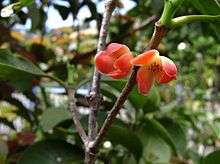Garcinia sessilis
Garcinia sessilis, known as heilala in Tongan, is an evergreen tree native to the Pacific regions of Solomon Islands, Fiji, Samoa and Tonga.[1] The heilala flower is the national flower of Tonga.[2]
| Garcinia sessilis | |
|---|---|
 | |
| Scientific classification | |
| Kingdom: | Plantae |
| Clade: | Tracheophytes |
| Clade: | Angiosperms |
| Clade: | Eudicots |
| Clade: | Rosids |
| Order: | Malpighiales |
| Family: | Clusiaceae |
| Genus: | Garcinia |
| Species: | G. sessilis |
| Binomial name | |
| Garcinia sessilis | |
Description
Garcinia sessilis grows to 4-20m, with a trunk diameter up to 30cm and abundant yellowish latex. Habitat ranges from dense or dry forest to the edges of mangrove swamps, from sea level to 1150m (in Fiji). The flower petals are from pink-tinged to carmine in colour. The fruits are yellowish-white to red at maturity with white pulp.[3]
Uses
The heilala flower is considered the most chiefly of flowers in Tongan culture.[4] It is prized for its fragrance[5] and often used to make garlands or kahoa.[6]
Heilala is traditionally used medicinally for morning sickness; as an eyewash; for skin rashes and stomach ache.[7]
References
- Kew Science (2017) Plants of the World Online
- "Tongan Symbols". worldatlas.com. Retrieved 16 October 2019.
- Smith & Darwin. (1974). Pacific Island Plants. Journal of the Arnold Arboretum. v.55, pp254-259. Retrieved from
- Thaman, K.H. (2007) Partnerships for progressing cultural democracy in teacher education in Pacific Island countries. In T. Townsend & R. Bates(Eds) Handbook of teacher education (p63) The Netherlands: Springer
- Heilala Malu: Tongan Framework for Suicide Prevention (2017) Le Va Online Resource
- Burrows, Sulieti (2015) Auckland Museum, Collections Online Neck Ornament
- Quattrocchi, Umberto.(2012) CRC World Dictionary of Medicinal and Poisonous Plants. (p1805) Boca Raton: CRC Press